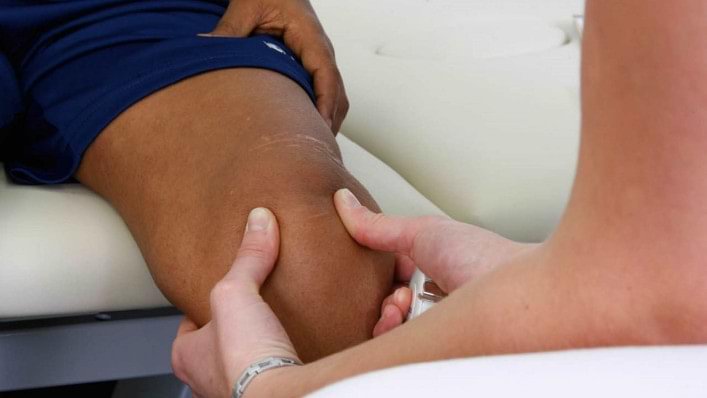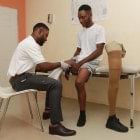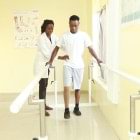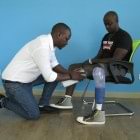Residual limb healing

Prepare your residual limb for wearing a prosthesis
The healing of your residual limb after the leg amputation forms the basis for the subsequent prosthetic fitting and is therefore especially important. In the hospital, your attending doctors will continuously monitor and check the healing process while the inpatient nursing staff looks after the daily treatment of your residual limb. In addition to wound treatment, this includes oedema and compression therapy, desensitising the skin, and scar care among other things.
Residual limb pain
Various types of pain may occur in your residual limb after an amputation. These may include bone pain, wound pain, nerve pain or phantom pain. Each type of pain is treated according to its cause. Various treatment options are available, such as medication, warming/cooling or wrapping the residual limb. You can talk to your specialist and/or pain therapist about this.
Wound healing
When you wake up from the anaesthetic, your leg will usually have a dressing already consisting of simple bandages or a cast with a small tube coming out of it. This tube was inserted into the wound during the operation in order to drain fluid and blood from the wound. Known as a drain, it is removed in the course of healing. The initial wound healing phase is usually completed within the first fourteen days, when the wound has closed. After this, the connective tissue cells grow stronger and are converted into specific connective tissue. But even if the scar appears to have healed well from the outside and only the colour of the scar tissue changes slightly from this point on, the overall scar healing process takes much longer. It can take up to one and a half years before it is fully healed beneath the skin. The duration of the wound healing process depends on the individual constitution.
Oedema therapy
After the operation, the tissue around the residual limb will usually be swollen. This swelling called oedema is a normal reaction to the operation. It usually subsides after about one week. Initially the objective is to minimise swelling on the residual limb, and subsequently to keep the volume, that is the circumference of the residual limb, stable. Your doctor should prescribe lymphatic drainage for oedema therapy. It is carried out by a physiotherapist or occupational therapist. The goal is to stimulate drainage and carry away the fluid that has accumulated in the residual limb after amputation. Following lymphatic drainage, the residual limb is treated using a special technique – compression bandages, compression socks or compression liners. Compression also minimises the residual limb volume.

Compression therapy after amputation

How to apply a compression liner after amputation?

How to apply a compression sock after amputation?
Soon after the amputation, pressure is put on large areas of the residual limb with the help of elastic bandages, compression socks or other medical aids. The purpose of compression therapy is to reduce the residual limb oedema and prepare your residual limb for your subsequent fitting with a prosthesis. This is important, because pronounced residual limb oedema would delay wound healing. Without compression therapy, it would also take longer for the residual limb to reach its final shape so that a prosthesis can be fitted. Compression also promotes circulation in the residual limb. This reduces pain and promotes healing of the scar. What type of residual limb care is most suitable for you – with elastic bandages, compression socks or a silicone liner – depends on various factors such as the amputation level, wound conditions and also the personal experiences of your treatment team.
Before you are discharged, the treatment team in the hospital can show you and your relatives how to continue applying compression at home.

Desensitising the skin
The skin on your residual limb is very sensitive following the operation. You can help desensitise your skin in close coordination with your treatment team – also jointly with your therapist. For example, gently rolling a rough towel or washing mitt over the sensitive skin can help. You can also lightly massage the residual limb with a brush using an upward motion. Using a massage ball with nubs helps make the skin less sensitive as well. Make sure to only do all of this in close coordination with your treatment team. They will also show you the proper techniques.
Scar care
The surgical wound on the residual limb generally closes within three to four weeks and a scar is formed. Even when it is well healed from the outside, the underlying scar tissue may not be entirely healed yet. This may take up to 18 months. Talk to your doctor or the nursing staff about scar care that is suitable for you. It may be advisable to moisten the scar quickly after the operation. Your therapist will train you in the optimal cleaning and massaging of the skin because the more soft and flexible your skin is, the better your residual limb is prepared for wearing a prosthesis.



